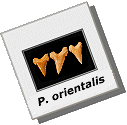| |

Palaeocarcharodon is arguably the most sought after Paleogene shark tooth in eastern North America. The striking similarity of these teeth, with those of the extant Great white undoubtedly feeds this collecting priority. Compared with Otodus (and most other sharks), this species' distribution is very limited in both time and space. This genus also serves as a flash-point in the Great white evolution debate. One viewpoint, as argued by Bob Purdy (1996), traces the lineage Palaeocarcharodon - Carcharodon auriculatus - Carcharodon megalodon - Carcharodon carcharias. The alternate scenario contends that Otodus evolved from Cretalamna, and terminated with Carcharocles megalodon (the modern Great white having nothing to do with either Palaeocarcharodon or C. megalodon). (See: Seque: Otodus-Carcharocles Slide Show.) In addition to rarity and importance, these teeth have another important feature — they are aesthetically very pleasing.
 Even if the stratigraphic position is unknown, it would be difficult not to recognize Palaeocarcharodon teeth. Labio-lingually compressed triangular teeth with coarse & irregular serrations and usually combined with serrate lateral cusplets is not a common tooth-design. In the western Atlantic, these are medium-sized teeth, usually less than 3 cm. Moroccan specimens exceed 5 cm with reports of them reaching the 6 cm range. The dentition is of a cutting-design (See: Palaeocarcharodon Slide Show) and has a delicate quality when compared with those of Otodus. Even if the stratigraphic position is unknown, it would be difficult not to recognize Palaeocarcharodon teeth. Labio-lingually compressed triangular teeth with coarse & irregular serrations and usually combined with serrate lateral cusplets is not a common tooth-design. In the western Atlantic, these are medium-sized teeth, usually less than 3 cm. Moroccan specimens exceed 5 cm with reports of them reaching the 6 cm range. The dentition is of a cutting-design (See: Palaeocarcharodon Slide Show) and has a delicate quality when compared with those of Otodus.
 Palaeocarcharodon orientalis (SINZOW, 1899) is currently thought to be the only valid member of this genus. Cappetta (1987) ascribed them to the Palaeocene of North & Western Africa and the Soviet Union. Case (1989, 1993) reported them from the Palaeocene of Maryland & New Jersey (USA) and Purdy (1998) from the Williamsburg Formation (Thanetian - Late Palaeocene) of South Carolina.. Their abrupt appearance and disappearance remains a mystery. Palaeocarcharodon orientalis (SINZOW, 1899) is currently thought to be the only valid member of this genus. Cappetta (1987) ascribed them to the Palaeocene of North & Western Africa and the Soviet Union. Case (1989, 1993) reported them from the Palaeocene of Maryland & New Jersey (USA) and Purdy (1998) from the Williamsburg Formation (Thanetian - Late Palaeocene) of South Carolina.. Their abrupt appearance and disappearance remains a mystery.
Also mysterious is the presence of two Palaeocarcharodon specimens (Figs. & ) in the Demopolis Fm. (early Late Campanian) of Mississippi. The time jump between these sediments and the normal occurrence suggests they were transported to this earlier horizon. So far lacking are other Paleocene specimens to validate the contamination hypothesis. However, the severe root erosion on these Frankstown orientalis teeth may explain why contemporary teeth are not found -- rootless teeth could be easily overlooked (Striatolamia as Scapanorhynchus, sand tigers as their Cretaceous counterparts, Hypolophus as Pseudohypolophus, Brachycarcharias lerichi as Serratolamna serrata, etc.).
References
Cappetta, H., 1987. Chondrichthyes II. Mesozoic and Cenozoic Elasmobranchii. In: Handbook of Paleoichthyologie, vol. 3b, Gustav Fischer Verleg, Stuttgart, 193 pp.
Case, G., 1989. Palaeocarcharodon orientalis (Sinzow) (Neoselachii: cretoxirhinidae),
from the Paleocene of Maryland, USA. Paleovertebrata, 19(1): 1-6.
Case, G., 1993. Probable occurrence of the shark genus Palaeocarcharodon ((Neoselachii: Cretoxirhinidae),in the Paleocene of New Jersy. Mosasaur, V: 73-74.
Purdy, R., 1996. Paleoecology of Fossil White Sharks. In: A.P. Kimley and D. G. Ainley. editors, Great White Sharks: The Biology of Carcharodon carcharias, pages 67-78. San Diego: Academic Press.
Purdy, R., 1998 Chondrichthyan Fishes from the Paleocene of South Carolina. In: Sanders, A. (ed) Paleobiology of the Williamsburg Formation (Black Mingo Group; Paleocene) of South Carolina, U.S.A. Transactions of Amer. Philo. Scty., Vol 88, Pt 4. pp 122-146
Sinzow, I., 1899. Notizen uber die Jura-, Kreide- und Neogen-Ablagerungen de Gouvernements Saratow, Simbirsk, Samara und Orenburg. Odessa Unvirsitet, Zapiski, 77:1-106.
|